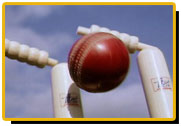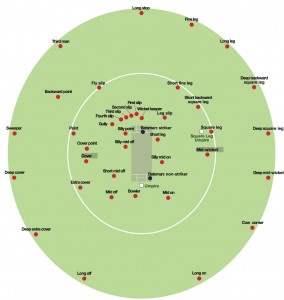The origins of cricket are obscure, and there are several theories on how it started. One is that shepherds used to play it – one would stand in front of the wicket gate to the sheep fold, and another would bowl a stone or something at him, and he would have to hit it with his crook, which was known as a cricce. Other theories are that it derives from a game called club-ball, or a game played in churchyards… wicket gate to the sheep fold, and another would bowl a stone or something at him, and he would have to hit it with his crook, which was known as a cricce. Other theories are that it derives from a game called club-ball, or a game played in churchyards…
The first reference to cricket being played is thought to be in 1300, between Prince Edward and his friend Piers Gaveston and the first recorded match took place at Coxheath in Kent in 1646. The first match between counties on 29th June 1709, when Surrey played Kent at Dartford Brent. The earliest known cricket photographs were taken in 1857, by Roger Fenton at the Artillery Ground, when the Royal Artillery played Hunsdonbury. The order in which the teams bat is determined by a coin toss. The captain of the side winning the toss may elect to bat or field first. All eleven players of the fielding team go out to field, two players of the batting team go out to bat. The remainder of the batting team wait off the field for their turn to bat. Each batsman wears protective gear and carries a cricket bat. The game progresses by the bowling of balls. The sequence of events which constitutes a ball follows. The fielding team disperses around the field, to positions designed to stop runs being scored or to get batsmen out. One fielder is the bowler. He takes the ball and stands some distance behind one of the wickets (i.e. away from the pitch). Another fielder is the wicket-keeper, who wears a pair of webbed gloves designed for catching the ball and protective pads covering the shins. He squats behind the opposite wicket. The rest of the fielders have no special equipment – gloves to assist catching the ball are not allowed to anyone but the wicket-keeper. One batsman stands behind each popping crease, near a wicket. The batsman farthest from the bowler is the striker, the other is the non-striker. The striker stands before his wicket, on or near the popping crease, in the batting stance. The batsman stands with his bat held down in front of the wicket, ready to hit the ball, which will be bowled from the other end of the pitch.The non-striker simply stands behind the other popping crease, waiting to run if necessary. The bowler takes a run-up from behind the non-striker’s wicket. He passes to one side of the wicket, and when he reaches the non-striker’s popping crease he bowls the ball towards the striker, usually bouncing the ball once on the pitch before it reaches the striker. The striker may then attempt to hit the ball with his bat. If he misses it, the wicket-keeper will catch it and the ball is completed. If he hits it, the two batsmen may score runs (described later). When the runs are completed, the ball is also considered completed. The ball is considered to be in play from the moment the bowler begins his run-up. It remains in play until any of several conditions occur (two common ones were just described), after which it is called dead. The ball is also dead if it lodges in the striker’s clothing or equipment. Once the ball is dead, it is returned to the bowler for the next delivery (another name for the bowling of a ball). Between deliveries, the batsmen may leave their creases and confer with each other. When one bowler has completed six balls, that constitutes an over. A different member of the fielding team is given the ball and bowls the next over – from the opposite end of the pitch. The batsmen do not change ends, so the roles of striker and non-striker swap after each over. Any member of the fielding team may bowl, so long as no bowler delivers two consecutive overs. Once a bowler begins an over, he must complete it, unless injured or suspended during the over. Another possibility during a ball is that a batsman may get out. There are ten different methods of being out – these will be described in detail later. If a batsman gets out, the ball is dead immediately, so it is impossible to get the other batsman out during the same ball. The out batsman leaves the field, and the next batsman in the team comes in to bat. The not out batsman remains on the field. The order in which batsmen come in to bat in an innings is not fixed. The batting order may be changed by the team captain at any time, and the order does not have to be the same in each innings. When ten batsmen are out, no new batsmen remain to come in, and the innings is completed with one batsman remaining not out. The roles of the teams then swap, and the team which fielded first gets to bat through an innings. When both teams have completed the agreed number of innings, the team which has scored the most runs wins. Whenever a batsman hits the ball during a delivery, he may score runs. A run is scored by the batsmen running between the popping creases, crossing over midway between them. When they both reach the opposite crease, one run is scored, and they may return for another run immediately. The fielding side attempts to prevent runs being scored by threatening to run out one of the batsmen. If the batsmen are attempting to take runs, and a fielder gathers the ball and hits a wicket with it, dislodging one or both bails, while no batsman is behind that wicket’s popping crease, then the nearest batsman is run out. Specifically, the batsman must have some part of his body or his bat (provided he is holding it) grounded behind (not on) the crease. The batsmen carry their bats as they run, and turning for another run is accomplished by touching the ground beyond the crease with an outstretched bat. The batsmen do not have to run at any time they think it is unsafe – it is common to hit the ball and elect not to run. If the batsmen run one or three (or five! rare, but possible), then they have swapped ends and their striker/non-striker roles are reversed for the next ball (unless the ball just completed is the end of an over). In addition to scoring runs like this, if a batsman hits the ball so that it reaches the boundary fence, he scores four runs, without needing to actually run them. If a batsman hits the ball over the boundary on the full, he scores six runs. If a four or six is scored, the ball is completed and the batsmen cannot be run out. If a spectator encroaches on to the field and touches the ball, it is considered to have reached the boundary. If a fielder gathers the ball, but then steps outside or touches the boundary while still holding the ball, four runs are scored. If a fielder catches the ball on the full and, either during or immediately after the catch, steps outside or touches the boundary, six runs are scored.
|
|

